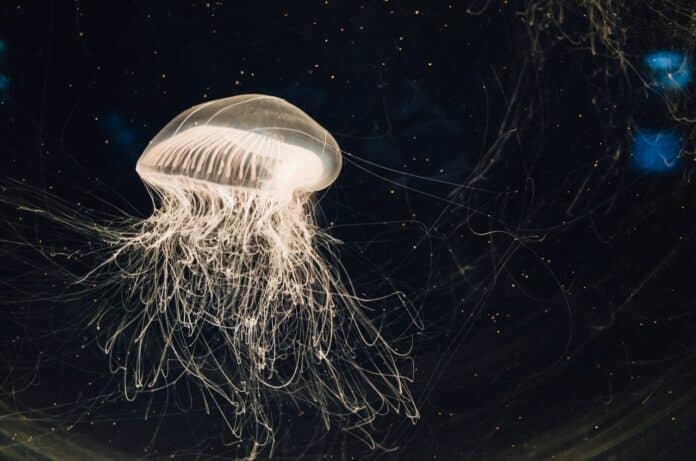Most of the world is covered in oceans, which are highly polluted. Ocean covers 70% of the Earth’s surface, but 80% is unmapped. Devices that operate underwater are essential for environmental applications. However, current prototypes frequently employ large, noisy actuators and limited configurations.
Roboticists at Stuttgart’s Max Planck Institute for Intelligent Systems (MPI-IS) have created a jellyfish-inspired underwater robot that they hope can collect waste from the ocean’s bottom. The almost silent prototype can trap things under its body without physical touch, allowing for safe interactions in sensitive situations like coral reefs. Jellyfish-Bot has the potential to be a major tool for environmental restoration.
They have created an underwater robot inspired by jellyfish that is adaptable, energy-efficient, and practically noise-free. Due to electrical motors or hydraulic pumps, the robot is designed to explore and sample in complicated and unstructured situations. It is hand-sized and capable of analyzing and sampling in complicated and unstructured surroundings.
The Physical Intelligence and Robotic Materials groups of MPI-IS worked together to create Jellyfish-Bot. For the robot to be stable and watertight, electrohydraulic actuators, air cushions, and soft and rigid components were used in its construction. The muscles contract and stretch due to periodic electricity flowing through thin cables from a power source, which enables the robot to swim beautifully and produce swirls underneath its body.
Tianlu Wang, a postdoc in the Physical Intelligence Department at Max Planck Institute -Intelligent System, said, “When a jellyfish swims upwards, it can trap objects along its path as it creates currents around its body. In this way, it can also collect nutrients. Our robot, too, circulates the water around it. This function is useful in collecting objects such as waste particles. It can then transport the litter to the surface, where it can later be recycled. It is also able to collect fragile biological samples such as fish eggs. Meanwhile, there is no negative impact on the surrounding environment. The interaction with aquatic species is gentle and nearly noise-free.”
His co-author, Hyeong-Joon Joo from the Robotic Materials Department, continues: “70% of marine litter is estimated to sink to the seabed. Plastics make up more than 60% of this litter, taking hundreds of years to degrade. Therefore, we saw an urgent need to develop a robot to manipulate objects such as litter and transport them upwards. We hope that underwater robots could one day assist in cleaning up our oceans.”
They can operate alone or in groups of several to move and trap items without making physical contact. The Jellyfish-Bots work more quickly than other related creations, with a top speed of 6.1 cm/s. Suppose the polymer material isolating the robot is torn apart.
In that case, they have a low input power requirement of approximately 100 mW and are safe for people and fish. The robot’s sounds can’t be separated from the ambient noise in the meanwhile. Jellyfish-Bot behaves similarly to its real-life equivalent by delicately interacting with its surroundings without upsetting them.
The robot is made up of various layers, including stiffening, flotation, and a polymer layer that acts as floating skin. HASELs are artificial muscles embedded in the layers—liquid dielectric-filled plastic pouches with electrodes on the outside. When a high voltage is applied across an electrode, it charges positively, while the surrounding water charges negatively.
This creates a force between the positively charged electrode and the negatively charged water, which pushes the oil inside the pouches back and forth, simulating the action of a proper muscle.
HASELs can withstand the high electrical stresses caused by charged electrodes and are water-resistant due to an insulating layer. This is significant since HASEL muscles have never before been employed to construct an underwater robot.
The initial stage was to create Jellyfish-Bot, which had a single electrode and six fingers or arms. The scientists then divided the single electrode into various groups to activate them individually in the second phase.
Hyeong-Joon Joo said, “We achieved grasping objects by making four of the arms function as a propeller and the other two as a gripper. Or we actuated only a subset of the arms to steer the robot in different directions. We also looked into how we can operate a collective of several robots. For instance, we took two robots and let them pick up a mask, which is very difficult for a single robot alone. Two robots can also cooperate in carrying heavy loads. However, at this point, our Jellyfish-Bot needs a wire. This is a drawback if we want to use it one day in the ocean“.
A buoyancy unit was added to the robot’s top, and a battery and microcontroller were attached to the bottom. They then took their innovation for a swim in the Max Planck Stuttgart campus pond, where they successfully directed it. So far, though, they have been unable to direct the wireless robot to alter course and swim in the opposite direction.
Tianlu Wang said, “We aim to develop wireless robots. Luckily, we have achieved the first step towards this goal. We have incorporated all the functional modules like the battery and wireless communication parts to enable future wireless manipulation.”
Journal Reference:
- Wang, T., Joo, J., Song, etal. A versatile jellyfish-like robotic platform for effective underwater propulsion and manipulation. Science Advances. DOI: 10.1126/sciadv.adg0292
